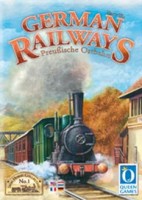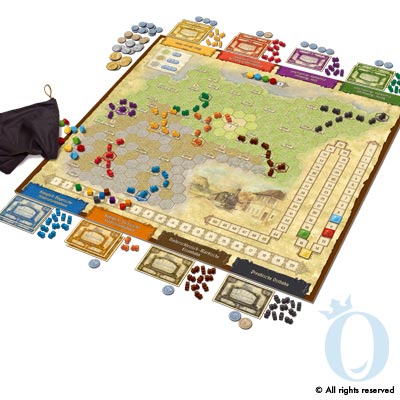
German Railways
3-5
12+
60
The first game in the new Iron Horse Collection! The 19th Century: Witness the time when proud iron horses pounded the earth and steamclouds rose up to the sky! Choose one of Germanys most efficient railway companies and lead it to greatness - again!

User Reviews (1)
Add a Review for "German Railways"
You must be logged in to add a review.

Originally published as Preußische Ostbahn by Winsome Games in 2008, German Railways is the first entry in Queen Games’ Iron Horse collection. Designed for three to five players, aged twelve plus, focuses on the foundation of Germany’s railroads between 1832 and 1872. Historically, some 200 railroads would help forge economic and cultural ties between the innumerable Germanic states, but German Railways focuses on just eight railroads and their shares. Players purchase shares and so seed each railroad with the capital necessary to increase both its network and its share value. The aim of the game is have the most money or ‘Talers’.
The game consists of three Railroad Shares, plus matching Railroad Income marker and rolling stock or Locomotives for each Railroad. Each player has a set of Player Turn Order markers and a Player Income marker. The board depicts Germany – its towns and cities, rural, hill, and mountainous regions – overlaid with a hex grid, plus tracks for the Player Turn Order, Railroad Income, and Player Incomes. Each railroad has a space on the edge of the board to hold its current capital. The game comes with rules in Dutch, English, French, and German.
Game set up involves placing the Railroad Income and the Player Income markers on the right tracks and placing the Locomotives on their starting cities. Each player receives some Talers, the amount depending upon the number of players. Then the first wave of shares are auctioned off in order – Preußische Ostbahn, Niederschlesische-Märkische Eisenbahn, Königlich-Sächsische Staatseisenbahnen, Königlich-Bayerische Staatseisenbahnen, Main-Weser-Bahn, Großherzoglich Badische Staatseisenbahnen, Cöln-Mindener Eisenbahn-Gesellschaft, and Berlin-Hamburger Eisenbahn-Gesellschaft. The other shares can be auctioned off during the game, but a whole wave must be auctioned off before the next is available.
Each player determines the total value of his shares and adjusts the position of his Player Income marker accordingly. Once Player Income is known, player order is determined. This is done by drawing five Player Turn Order markers from a provided cloth bag and putting them on the Player Turn Order track. The player with the highest Player Income puts a single marker into the bag, the player with the second highest Player Income puts two markers into the bag, and so on. This means that the player with the highest Player Income has the least chance of taking an action each round, whereas the player with least Player Income has the most chance of taking multiple actions each round.
On his turn a player can do one of three things. He can choose to pass, he can put up a Railroad Share up for auction, or he can build track. To Build Track, a player selects a Railroad in which he owns one or more Shares in and spends the capital invested in it to add Locomotives to that Railroad’s existing network. Usually three Locomotives, but may be more or less depending upon the Railroad. Each Railroad has a special feature, not always a beneficial one. For example, the efficient Preußische Ostbahn can build four Locomotives rather than three, whilst the Share Dividend focused Cöln-Mindener Eisenbahn-Gesellschaft may no more than five Talers on building track.
When track is built into urban and city hexes, it increases the value of the Railroad Share by one and thus the Player Income of any player who owns shares in the Railroad, though some cities increase the value by more than one. If track is built from one Railroad into another in urban or city hex, a connection is made and Dividends are paid out on all Shares currently owned. Anyone who owns shares in the connecting Railroad receives a double Dividend. Only one connection can be made between two Railroads to get this Dividend. When each Railroad has made two connections, the game ends.
Initially players have limited funds to invest, so each Railroad receives limited capital with which to Build Track and increase its value. Thus Dividends will be low, but as Railroads expand, their share values increase, giving greater Dividends and thus more money with which to purchase more shares. Towards the game’s end, a player must choose carefully between purchasing shares and keeping his money. The key is knowing if a share’s potential dividend is worth the auction value. Pay too much for a share and a player reduces his chances of winning.
In addition, alliances are formed throughout the game between players who own shares in the same Railroad. This is one of expediency as the opportunity to make a connection and thus gain the double Dividend will benefit the share owners of the connecting Railroad. Plus when connections are made, everyone receives a Dividend and that includes any player who does not have a turn that round.
German Railways is mostly well designed and presented, but the colours of some shares and locomotives do not quite match. Plus the colour of some shares are washed out and difficult to tell apart. Gameplay is not eased as the Railroad special features are only listed in the middle of the rulebook, whereas they should have been listed on the shares.
Some players will hate German Railways’ means of determining turn order. The clever mechanism is designed to enable trailing players to have a chance of more turns and catch up, but it often means that some players have nothing to do for a whole round. Nevertheless, they can still benefit from Dividends and can still participate in auctions. Lastly play time is listed as 60 minutes – it is more like 90.
Ultimately, whether you like German Railways or not depends upon whether you like the Turn Order mechanism. It is the game’s divisive design feature. Plus the game is a share manipulation game rather than a railway game. That said, so is Paris Connection with which German Railways shares the same publishers. German Railways is more complex than Paris Connection, but not by much and the complexity comes in determining share values. Get that right and you will be the master of the German Railways.